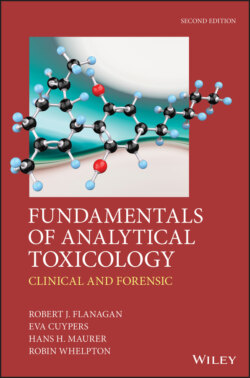Читать книгу Fundamentals of Analytical Toxicology - Robin Whelpton - Страница 22
1.2.4 Trace elements and toxic metals
ОглавлениеIn order to help diagnose either deficiencies or chronic poisoning with these substances, where alterations from target ranges of only a few μg L–1 (parts per billion, ppb, i.e. parts per thousand million) of blood or serum can be important, good accuracy and reproducibility are essential (Wang et al., 2014). Sample contamination during collection (for example from sample tubes, or even from syringe needles in the case of chromium and manganese) and within the laboratory itself can be a serious source of error. This applies especially to widespread elements such as lead and aluminium.
Modern methods for measuring toxic metals in biological materials (Table 1.2) vary enormously in terms of complexity, cost, accuracy, and sensitivity. In the case of serum iron, however, reliable kits based on the formation of a coloured complex remain widely used in clinical chemistry. Some techniques (isotope dilution mass spectrometry, neutron activation analysis), on the other hand, are in reality reference methods. Atomic absorption spectrophotometry (AAS) with either flame or electrothermal atomization using a graphite furnace has been employed widely, but is being superseded by inductively coupled plasma-mass spectrometry (ICP-MS).
Table 1.2 Methods for the analysis of toxic metals in biological materials
| Technique | Mode | Variant |
| Electrochemical | PotentiometricCoulometric | Ion selective electrodes(Differential pulse) polarographyAnodic/cathodic stripping voltammetry (A/CSV)a |
| Spectrophotometric | Optical Emission (OES) | Flame emission photometry (FEP)b Direct-current plasma Inductively coupled plasma (ICP) |
| Atomic Absorption (AAS) | FlameHydride generationElectrothermalCold vapour | |
| X-Ray | Fluorescence | |
| Nuclear | Neutron activationProton activation | |
| Mass spectrometric | Inductively coupled plasma (ICP-MS) |
aAlso known as potentiometric stripping analysis (PSA)
bNormally refers to the use of filters to select the emission wavelength – used mainly for potassium, lithium, and sodium assay
ICP-MS is a multi-element technique that can detect and measure isotopes with detection limits of μg L–1 to ng L–1. Different isotopes of an element can also be measured. For some elements, the relative abundance of the isotopes depends upon the source of the metal. Therefore, by measuring the isotope ratios of an element such as lead in a sample from a chronically poisoned patient with those found in material present in the patient's immediate environment it may be possible to localize the source of exposure (Gulson, 2008).
Although ICP-MS measures (isotopes of) elements, it cannot differentiate between toxic and non-toxic arsenic species, for example, without a prior separation step (Hsu et al., 2011). Even then, phenomena such as adduct formation and/or spectral interference from isotopes of different elements can confuse an analysis unless special precautions are taken (Balcaen et al., 2015; Section 21.4.4.3).
